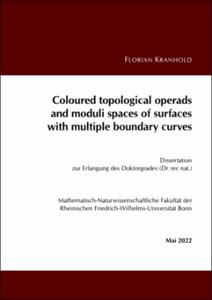Kranhold, Florian: Coloured topological operads and moduli spaces of surfaces with multiple boundary curves. - Bonn, 2022. - Dissertation, Rheinische Friedrich-Wilhelms-Universität Bonn.
Online-Ausgabe in bonndoc: https://nbn-resolving.org/urn:nbn:de:hbz:5-67204
Online-Ausgabe in bonndoc: https://nbn-resolving.org/urn:nbn:de:hbz:5-67204
@phdthesis{handle:20.500.11811/10004,
urn: https://nbn-resolving.org/urn:nbn:de:hbz:5-67204,
author = {{Florian Kranhold}},
title = {Coloured topological operads and moduli spaces of surfaces with multiple boundary curves},
school = {Rheinische Friedrich-Wilhelms-Universität Bonn},
year = 2022,
month = jul,
note = {While it is a classical result that the collection of moduli spaces of surfaces with a single boundary curve is anE2-algebra (more precisely: it admits an action of the little 2-cubes operad C2), we need a coloured version of C2 which understands a cluster of squares as a single input with a certain multiplicity, if we want to establish an action on the collection of moduli spaces of surfaces with multiple boundary curves in a similar way.
Moreover, Bödigheimer introduced a finite multisimplicial model for moduli spaces, which is useful for explicit homological calculations. In order to construct an operadic action on this specific model, we have to additionally require a certain coupling behaviour among squares belonging to the same input. This gives rise to a family of suboperads, called vertical operads.
We analyse these operads from several perspectives: on the one hand, their operation spaces and free algebras are modelled by clustered and vertical configuration spaces, whose homology, homological stability, and iterated bar constructions we investigate in the first chapters. On the other hand, we study the homotopy theory and the homology of their algebras and use the arising operations to describe the unstable homology of moduli spaces.
Finally, it turns out that the developed methods are also useful to solve a problem of a seemingly different flavour: for a fixed space A, the collection of moduli spaces of surfaces parametrised over A is itself anE2-algebra, and its group completion is an infinite loop space. We identify the underlying spectrum in the spirit of Madsen and Weiss.},
url = {https://hdl.handle.net/20.500.11811/10004}
}
urn: https://nbn-resolving.org/urn:nbn:de:hbz:5-67204,
author = {{Florian Kranhold}},
title = {Coloured topological operads and moduli spaces of surfaces with multiple boundary curves},
school = {Rheinische Friedrich-Wilhelms-Universität Bonn},
year = 2022,
month = jul,
note = {While it is a classical result that the collection of moduli spaces of surfaces with a single boundary curve is an
Moreover, Bödigheimer introduced a finite multisimplicial model for moduli spaces, which is useful for explicit homological calculations. In order to construct an operadic action on this specific model, we have to additionally require a certain coupling behaviour among squares belonging to the same input. This gives rise to a family of suboperads, called vertical operads.
We analyse these operads from several perspectives: on the one hand, their operation spaces and free algebras are modelled by clustered and vertical configuration spaces, whose homology, homological stability, and iterated bar constructions we investigate in the first chapters. On the other hand, we study the homotopy theory and the homology of their algebras and use the arising operations to describe the unstable homology of moduli spaces.
Finally, it turns out that the developed methods are also useful to solve a problem of a seemingly different flavour: for a fixed space A, the collection of moduli spaces of surfaces parametrised over A is itself an
url = {https://hdl.handle.net/20.500.11811/10004}
}






